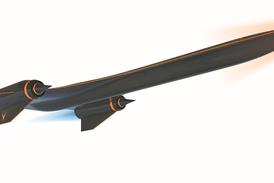The terrorist threat is changing
Several
Briefing the results of an 18-month, $6.5 million, company-funded study into how to defend the heavily populated north-east USA against the “asymmetric threat” of ballistic or cruise missiles launched by terrorists from ships offshore, Lockheed Martin pointed out that Europe’s population centres are similarly vulnerable. But the postulated threat, and proposed defence, came across as uniquely American.
As evidence to support the existence of such a threat, Dave Kier, Lockheed Martin vice-president and managing director of missile defence and protection programmes, cites the discovery of a Scud missile and launcher in a container at
Short-range rockets such as the Scud are easy to conceal, Kier said, while cruise missiles like the Chinese-made Silkworm have 10 times the accuracy when fitted with GPS navigation. “A rogue state has launched a ballistic missile and a cruise missile from a ship,” he said, adding that a ship-launched cruise missile could strike the
Lockheed’s internal study developed the architecture for an asymmetric missile defence system that could be deployed to protect the
Missile shield
The missile shield would be created by repositioning existing Aegis air-defence ships and Patriot PAC-3 anti-missile batteries. Three Aegis ships and 12 Patriot fire units would be needed to cover the
Defending a heavily populated region from missile attack without turning it into a fortress poses unique challenges, including the need for sensors that are both deployable and publicly acceptable, Kier says. Command and control systems will have to be extended to include “consequence and crisis” management to deal with missile debris and provide links to emergency services.
While ballistic missiles can be detected by existing and planned early-warning satellites, Lockheed’s solution to the cruise missile threat is passive coherent location. This uses transmissions from existing FM radio stations to detect the missile. “We can detect disturbances in the broadcast radio-frequency field, triangulate and locate the target,” says Kier. Testing against cruise missiles has been conducted at White Sands missile range in
Lockheed proposes evolving its architecture between 2007 and 2013 into a “fully integrated, networked, persistent asymmetric missile defence system”. This would involve introducing the aerostat-based JLENS cruise-missile defence sensor in 2011 and the proposed high-altitude surveillance airship in 2013.
Although Lockheed’s proposal seems far-fetched, it has attracted the attention of at least one Congressional committee, which has added $20 million to its mark-up of the 2006
So far, Lockheed seems to be ahead of its potential customer, the US Department of Defense. Although US Northern Command is responsible for homeland defence, it lacks acquisition authority and must procure systems through the individual services. It remains to be seen whether they will place a high enough priority on protecting the
GRAHAM
Source: Flight International























